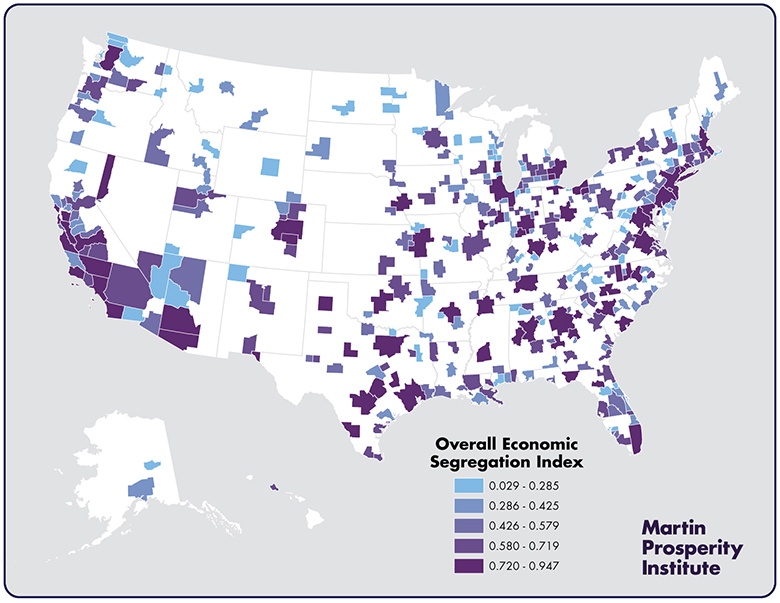Wrote a little bit about this last March, but here’s some new information and ideas around it. This looks at segregation as a factor of income, education, and occupation (as opposed to simply income, which is how a lot of people look at segregation). This is different than “Which city has the highest/lowest inequality?” That implies a gap between the highest and the lowest; this implies that the lowest tend to live together more, as do the highest. (Rich pockets and very poor pockets, which all cities have, but in different measure.)
So, what have we learned?
Here’s all metros (not just big or small or whatever size) in terms of high economic segregation:
Here it is in terms of low economic segregation:
Interestingly, a lot of the “high” category tends to be mid-size to large-sized college towns; that probably says something about how people get jobs after college, and what the “creative class” is able to do that maybe some other majors/ideas about their future aren’t.
Here it is in terms of high economic segregation for big cities:
Again, a lot of college towns on there. They can be good economic models, but they can also foster a lot of “affluent living with affluent” and “less-so with less-so.”
Here it is in terms of low economic segregation for big cities:
People love to tell you to move to Minneapolis — although I maybe have some different thoughts on that idea — but it’s a good, livable city for sure. Providence is oft-considered an afterthought of the Northeast corridor and/or part of the Rust Belt, but it’s making a comeback. I’ve seen studies about how great Cincinnati and Hartford are in terms of opportunities for young people, and I’ve actually written the same about Tampa.
Broader takeaways: you can make your own, but if you’re interested in a big city lifestyle without as much economic segregation, you have multiple options to choose from in terms of areas of the country — although three of those top 10 are in north-to-middle Florida (JAX, Tampa, and Orlando), so maybe heading there is for the best.
Interestingly, perhaps, Tallahassee is No. 1 above overall for economic segregation (high levels). And guess what? It also has the least sprawl since 2000. Correlation? Perhaps.





This is an insightful look at the symptoms of an economic disparity problem, but the cause of economic disparity still needs to be addressed. To that end, there is a very strong argument for implementing an “unconditional basic income,” which would provide a yearly salary to negate the inevitability of the need for fewer workers. This is a great idea, and has been suggested in the past by US economists, but, of course, it would require real progressive thinking and leadership to implement in the US.
Although, this type of system is being considered in Switzerland. Here’s a link that explains more…http://www.fastcoexist.com/3041719/change-generation/work-is-bullshit-the-argument-for-antiwork
I actually sent that FastCoExist article to a couple of my college friends this morning. Great minds think somewhat similarly, my man.
I actually sent that FastCoExist article to a couple of my college friends this morning. Great minds think somewhat similarly, my man.